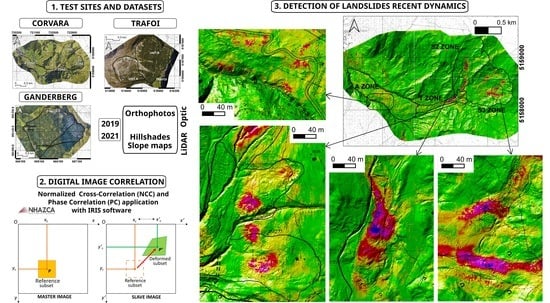Detecting Recent Dynamics in Large-Scale Landslides via the Digital Image Correlation of Airborne Optic and LiDAR Datasets: Test Sites in South Tyrol (Italy)
Abstract
:1. Introduction
2. Materials and Methods
2.1. Test Sites
2.2. Materials
2.3. Methods
3. Results
3.1. Corvara Landside
3.2. Ganderberg Landside
3.3. Trafoi Landside
4. Discussion
4.1. Explanation for the Observed Landslide Deformation Patterns
4.2. Performances of PC and NCC in the Recognition of Slope Movements on a Qualitative Basis
4.3. Performances of PC and NCC Algorithms to Assess Displacement on a Quantitative Basis
5. Conclusions
Author Contributions
Funding
Data Availability Statement
Acknowledgments
Conflicts of Interest
References
- Highland, L.M.; Bobrowsky, P. The Landslide Handbook—A Guide to Understanding Landslides; U.S. Geological Survey Circular 1325: Reston, VA, USA, 2008.
- Stumpf, A.; Malet, J.P.; Delacourt, C. Correlation of Satellite Image Time—Series for the Detection and Monitoring of Slow-Moving Landslides. Remote Sens. Environ. 2017, 189, 40–55. [Google Scholar] [CrossRef]
- Gariano, S.L.; Guzzetti, F. Landslides in a Changing Climate. Earth Sci. Rev. 2016, 162, 227–252. [Google Scholar] [CrossRef] [Green Version]
- Titti, G.; Napoli, G.N.; Conoscenti, C.; Lombardo, L. Cloud-Based Interactive Susceptibility Modeling of Gully Erosion in Google Earth Engine. Int. J. Appl. Earth Obs. Geoinf. 2022, 115, 103089. [Google Scholar] [CrossRef]
- Huggel, C.; Gruber, S.; Korup, O. Landslide Hazards and Climate Change in High Mountains. Treatise Geomorphol. 2013, 13, 288–301. [Google Scholar] [CrossRef]
- Mulas, M.; Ciccarese, G.; Truffelli, G.; Corsini, A. Displacements of an Active Moderately Rapid Landslide—A Dataset Retrieved by Continuous GNSS Arrays. Data 2020, 5, 71. [Google Scholar] [CrossRef]
- Frigerio, S.; Schenato, L.; Bossi, G.; Cavalli, M.; Mantovani, M.; Marcato, G.; Pasuto, A. A Web-Based Platform for Automatic and Continuous Landslide Monitoring: The Rotolon (Eastern Italian Alps) Case Study. Comput. Geosci. 2014, 63, 96–105. [Google Scholar] [CrossRef]
- Debella-Gilo, M.; Kääb, A. Sub-Pixel Precision Image Matching for Measuring Surface Displacements on Mass Movements Using Normalized Cross-Correlation. Remote Sens. Environ. 2011, 115, 130–142. [Google Scholar] [CrossRef] [Green Version]
- Mulas, M.; Ciccarese, G.; Truffelli, G.; Corsini, A. Integration of Digital Image Correlation of Sentinel-2 Data and Continuous GNSS for Long-Term Slope Movements Monitoring in Moderately Rapid Landslides. Remote Sens. 2020, 12, 2605. [Google Scholar] [CrossRef]
- Meng, Y.; Lan, H.; Li, L.; Wu, Y.; Li, Q. Characteristics of Surface Deformation Detected by X-Band SAR Interferometry over Sichuan-Tibet Grid Connection Project Area, China. Remote Sens. 2015, 7, 12265–12281. [Google Scholar] [CrossRef] [Green Version]
- Wang, Z.; Kieu, H.; Nguyen, H.; Le, M. Digital Image Correlation in Experimental Mechanics and Image Registration in Computer Vision: Similarities, Differences and Complements. Opt. Lasers Eng. 2015, 65, 18–27. [Google Scholar] [CrossRef]
- Pan, B.; Li, K. A Fast Digital Image Correlation Method for Deformation Measurement. Opt. Lasers Eng. 2011, 49, 841–847. [Google Scholar] [CrossRef]
- Pan, B.; Xie, H.M.; Xia, Y.; Wang, Q. Large-Deformation Measurement Based on Reliable Initial Guess in Digital Image Correlation Method. Acta Optica Sinica 2009, 29, 400–406. [Google Scholar] [CrossRef]
- Daehne, A.; Corsini, A. Kinematics of Active Earthflows Revealed by Digital Image Correlation and DEM Subtraction Techniques Applied to Multi-Temporal LiDAR Data. Earth Surf. Process. Landf. 2013, 38, 640–654. [Google Scholar] [CrossRef]
- Okyay, U.; Telling, J.; Glennie, C.L.; Dietrich, W.E. Airborne Lidar Change Detection: An Overview of Earth Sciences Applications. Earth Sci. Rev. 2019, 198, 102929. [Google Scholar] [CrossRef]
- Bickel, V.T.; Manconi, A.; Amann, F. Quantitative Assessment of Digital Image Correlation Methods to Detect and Monitor Surface Displacements of Large Slope Instabilities. Remote Sens. 2018, 10, 865. [Google Scholar] [CrossRef] [Green Version]
- Caporossi, P.; Mazzanti, P.; Bozzano, F. Digital Image Correlation (DIC) Analysis of the 3 December 2013 Montescaglioso Landslide (Basilicata, Southern Italy): Results from a Multi-Dataset Investigation. Can. Hist. Rev. 2018, 7, 372. [Google Scholar] [CrossRef] [Green Version]
- Corsini, A.; Pasuto, A.; Soldati, M.; Zannoni, A. Field Monitoring of the Corvara Landslide (Dolomites, Italy) and Its Relevance for Hazard Assessment. Geomorphology 2005, 66, 149–165. [Google Scholar] [CrossRef]
- Thiebes, B.; Tomellari, E.; Mejia-Aguilar, M.; Rabanser, M.; Schlögel, R.; Mulas, M.; Corsini, A. Assessment of the 2006 to 2015 Corvara Landslide Evolution a UAV-Derived DSM and Orthophoto. In Landslides and Engineered Slopes. Experience, Theory and Practice; CRC Press: London, UK, 2018; pp. 1897–1902. [Google Scholar] [CrossRef] [Green Version]
- Corsini, A.; Marchetti, M.; Soldati, M. Holocene Slope Dynamics in the Area of Corvara in Badia (Dolomites, Italy): Chronology and Paleoclimatic Significance of Some Landslides. Geogr. Fis. Dinam. Quat. 2001, 24, 127–139. [Google Scholar]
- Schlögel, R.; Thiebes, B.; Mulas, M.; Cuozzo, G.; Notarnicola, C.; Schneiderbauer, S.; Crespi, M.; Mazzoni, A.; Mair, V.; Corsini, A. Multi-Temporal x-Band Radar Interferometry Using Corner Reflectors: Application and Validation at the Corvara Landslide (Dolomites, Italy). Remote Sens. 2017, 9, 739. [Google Scholar] [CrossRef] [Green Version]
- Corsini, A.; Iasio, C.; Mair, V. Overview of 2001–08 GPS Monitoring at the Corvara Landslide and Perspectives from 2010–11 Use of HR X-Band SAR (Dolomites, Italy). In Landslides and Engineered Slopes: Protecting Society through Improved Understanding; Eberhardt, E., Froese, C., Turner, K., Leroueil, S., Eds.; Taylor & Francis Group: London, UK, 2012; Volume 2, pp. 1353–1358. ISBN 9780415621236. [Google Scholar]
- Schädler, W.; Borgatti, L.; Corsini, A.; Meier, J.; Ronchetti, F.; Schanz, T. Geomechanical Assessment of the Corvara Earthflow through Numerical Modelling and Inverse Analysis. Landslides 2015, 12, 495–510. [Google Scholar] [CrossRef]
- Mulas, M.; Petitta, M.; Corsini, A.; Schneiderbauer, S.; Mair, F.V.; Iasio, C. Long-Term Monitoring of a Deep-Seated, Slow-Moving Landslide by Mean of C-Band and X-Band Advanced Interferometric Products: The Corvara in Badia Case Study (Dolomites, Italy). Int. Arch. Photogramm. Remote Sens. Spatial Inf. Sci. 2015, 40, 827–829. [Google Scholar] [CrossRef] [Green Version]
- Iasio, C.; Novali, F.; Corsini, A.; Mulas, M.; Branzanti, M.; Benedetti, E.; Giannico, C.; Tamburini, A.; Mair, V. COSMO SkyMed High Frequency—High Resolution Monitoring of an Alpine Slow Landslide, Corvara in Badia, Northern Italy. In Proceedings of the 2012 IEEE International Geoscience and Remote Sensing Symposium, Munich, Germany, 22–27 July 2012; pp. 7577–7580. [Google Scholar] [CrossRef]
- Mulas, M.; Corsini, A.; Cuozzo, G.; Callegari, M.; Thiebes, B.; Mair, V. Quantitative Monitoring of Surface Movements on Active Landslides by Multi-Temporal, High-Resolution X-Band SAR Amplitude Information: Preliminary Results. In Landslides and Engineered Slopes. Experience, Theory and Practice; CRC Press: London, UK, 2016; pp. 1511–1516. [Google Scholar] [CrossRef] [Green Version]
- Bossi, G.; Mair, V.; Mantovani, M.; Marcato, G.; Nössing, L.; Pasuto, A.; Stefani, M. The Ganderberg Landslide (South Tyrol, Italy): Residual Hazard Assessment and Risk Scenarios. In Proceedings of the 11th International and 2nd North American Symposium on Landslide and Engineered Slopes, Banff, Canada, 3–8 June 2012. [Google Scholar]
- Bossi, G.; Frigerio, S.; Mantovani, M.; Schenato, L.; Pasuto, A.; Marcato, G. Hazard Assessment of a Potential Rock Avalanche in South Tyrol, Italy: 3D Modeling and Risk Scenarios. Ital. J. Eng. Geol. Environ. 2013, 2013, 221–227. [Google Scholar] [CrossRef]
- Iannacone, J.P.; Quan Luna, B.; Corsini, A. Forward Simulation and Sensitivity Analysis of Run-out Scenarios Using MassMov2D at the Trafoi Rockslide (South Tyrol, Italy). Georisk 2013, 7, 240–249. [Google Scholar] [CrossRef]
- Corsini, A.; Iannacone, J.P.; Ronchetti, F.; Salvini, R.; Mair, V.; Nössing, L.; Stefani, M.; Unterthiner, G.; Valentinotti, G. Hot Spots for Simplified Risk Scenarios of the Trafoi Rockslide (South Tyrol). In Proceedings of the Landslide Science and Practice: Risk Assessment, Management and Mitigation—2nd World Landslide Forum, WLF 2011, Rome, Italy, 3–9 October 2011; Springer Science and Business Media Deutschland GmbH: Berlin/Heidelberg, Germany, 2013; Volume 6, pp. 739–745. [Google Scholar]
- Heid, T.; Kääb, A. Evaluation of Existing Image Matching Methods for Deriving Glacier Surface Displacements Globally from Optical Satellite Imagery. Remote Sens. Environ. 2012, 118, 339–355. [Google Scholar] [CrossRef]
- Tong, X.; Luan, K.; Stilla, U.; Ye, Z.; Xu, Y.; Gao, S.; Xie, H.; Du, Q.; Liu, S.; Xu, X.; et al. Image Registration with Fourier-Based Image Correlation: A Comprehensive Review of Developments and Applications. IEEE J. Sel. Top. Appl. Earth Obs. Remote Sens. 2019, 12, 4062–4081. [Google Scholar] [CrossRef]
- Brunetti, A.; Gaeta, M.; Mazzanti, P. Multi-Frequency and Multi-Resolution EO Images for Smart Asset Management. In Proceedings of the International Geoscience and Remote Sensing Symposium (IGARSS), Kuala Lumpur, Malaysia, 17–22 July 2022; pp. 5192–5195. [Google Scholar] [CrossRef]
- Hermle, D.; Gaeta, M.; Keuschnig, M.; Mazzanti, P.; Krautblatter, M. Multi-Temporal Analysis of Optical Remote Sensing for Time-Series Displacement of Gravitational Mass Movements, Sattelkar, Obersulzbach Valley, Austria. In Proceedings of the 23rd EGU General Assembly, online, 19–30 April 2021. [Google Scholar]
- Mazza, D.; Cosentino, A.; Romeo, S.; Mazzanti, P.; Guadagno, F.M.; Revellino, P. Remote Sensing Monitoring of the Pietrafitta Earth Flows in Southern Italy: An Integrated Approach Based on Multi-Sensor Data. Remote Sens. 2023, 15, 1138. [Google Scholar] [CrossRef]
- R Core Team. R: A Language and Environment for Statistical Computing 2022; R Foundation for Statistical Computing: Vienna, Austria, 2022. [Google Scholar]
- Mazzanti, P.; Caporossi, P.; Muzi, R. Sliding Time Master Digital Image Correlation Analyses of Cubesat Images for Landslide Monitoring: The Rattlesnake Hills Landslide (USA). Remote Sens. 2020, 12, 592. [Google Scholar] [CrossRef] [Green Version]


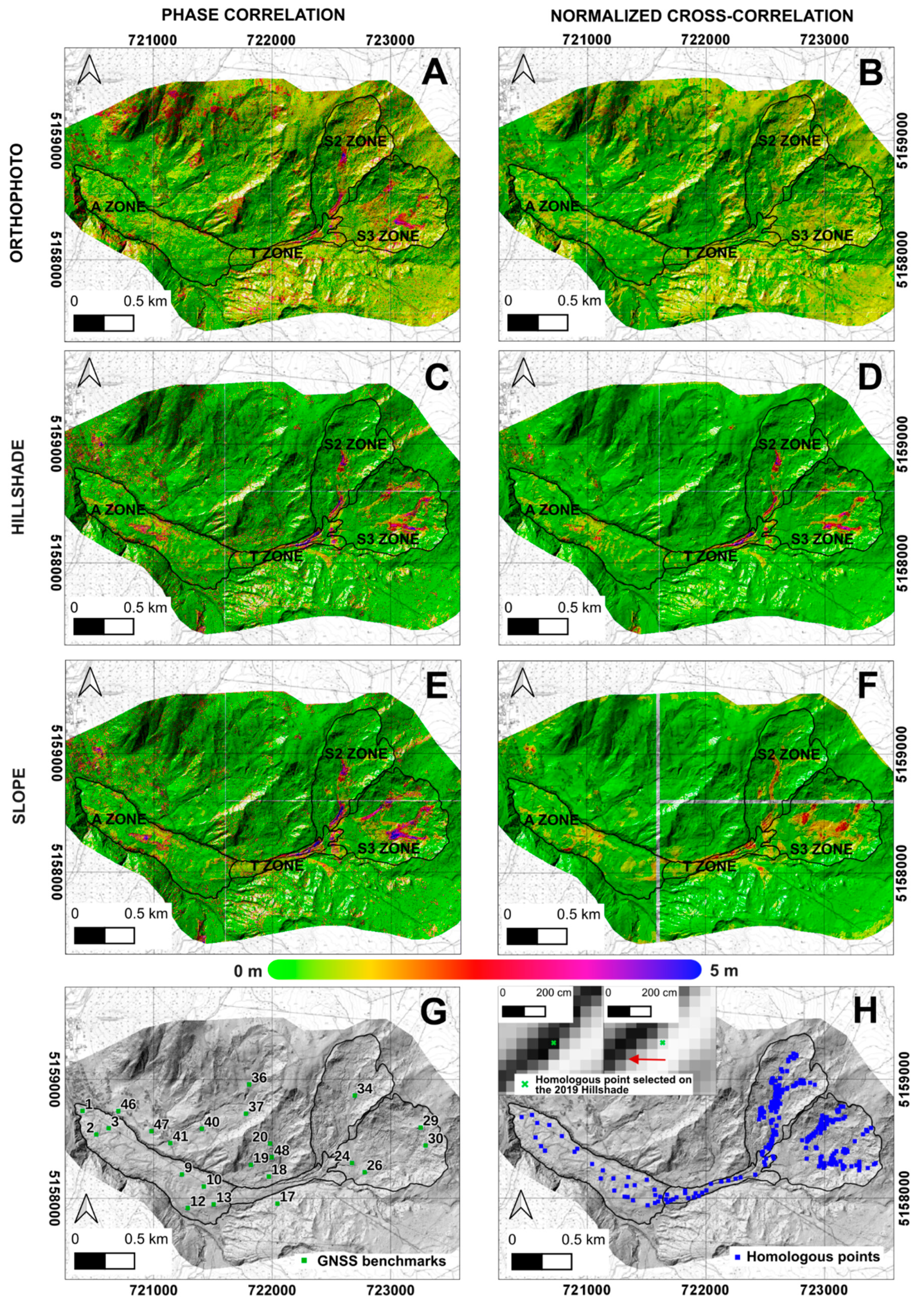

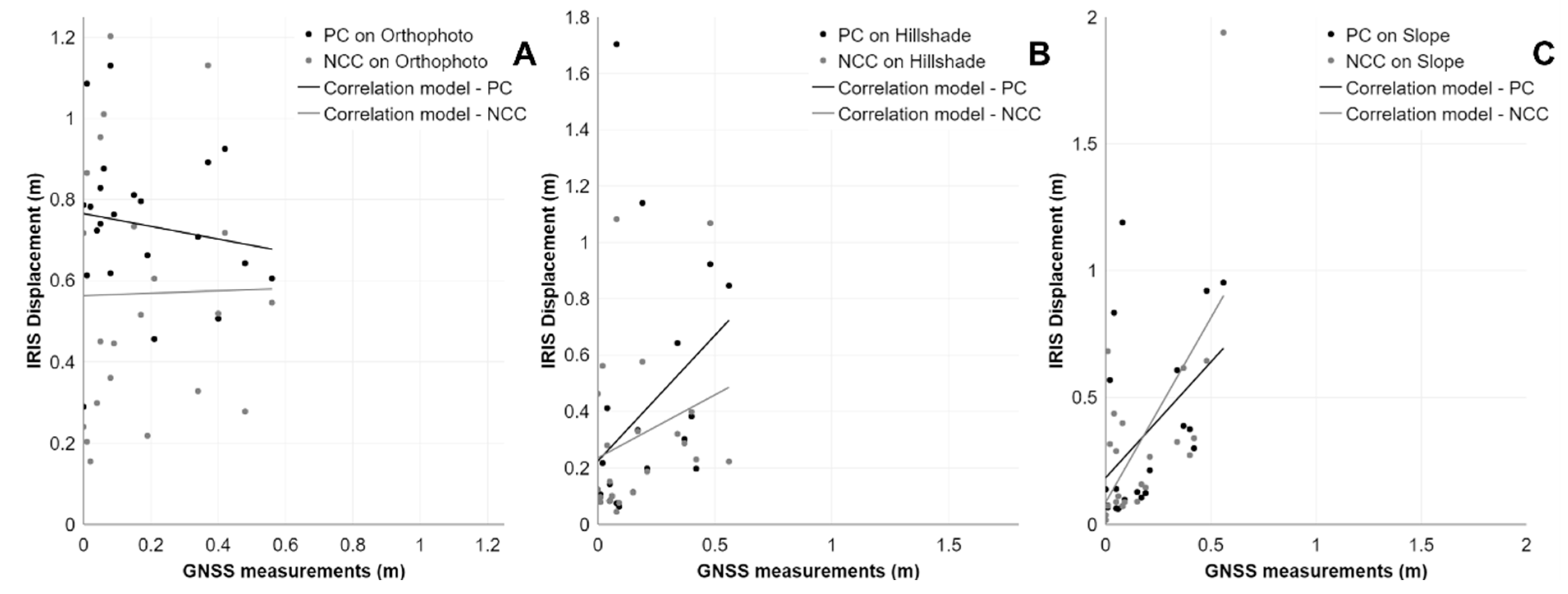
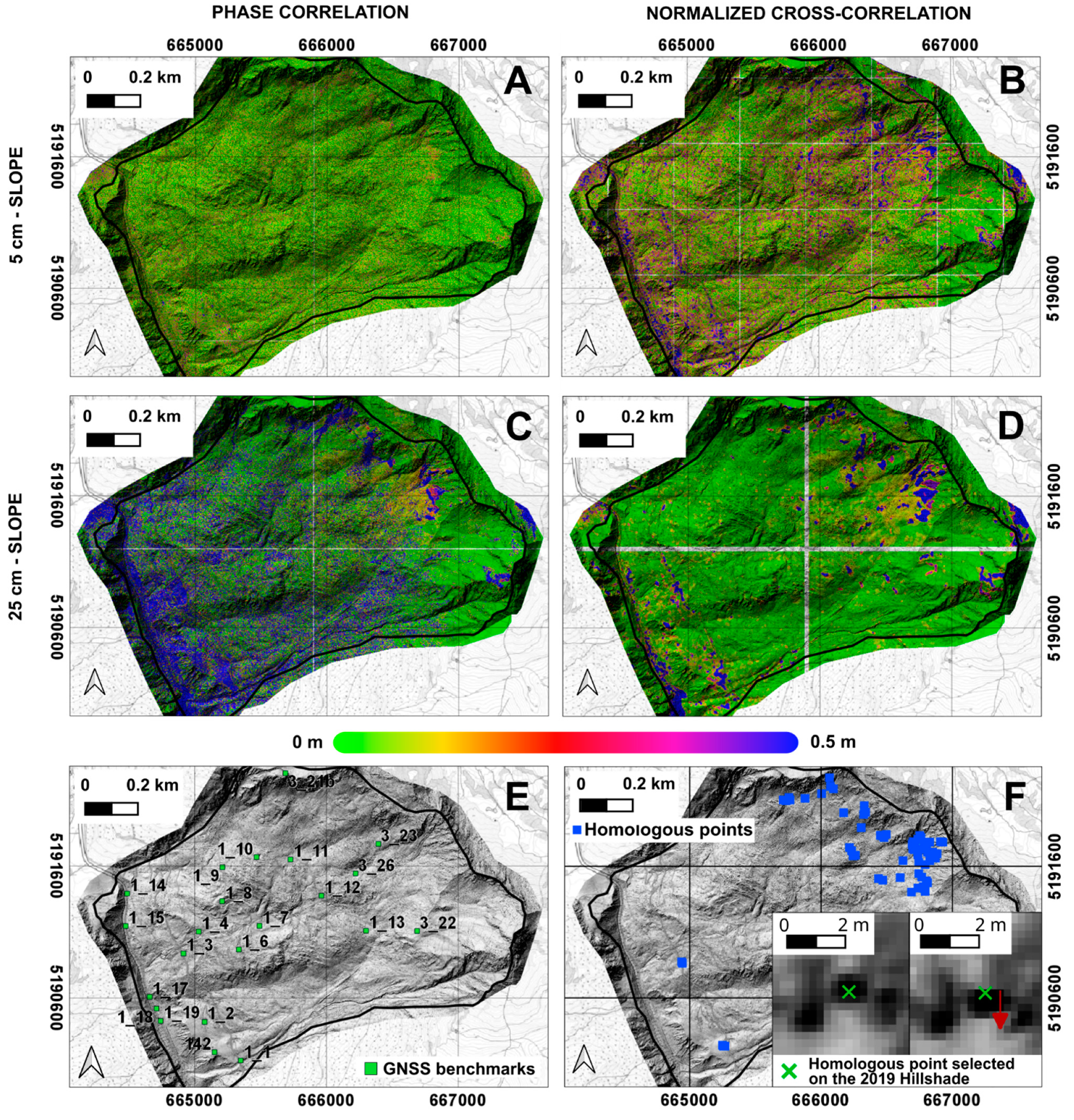
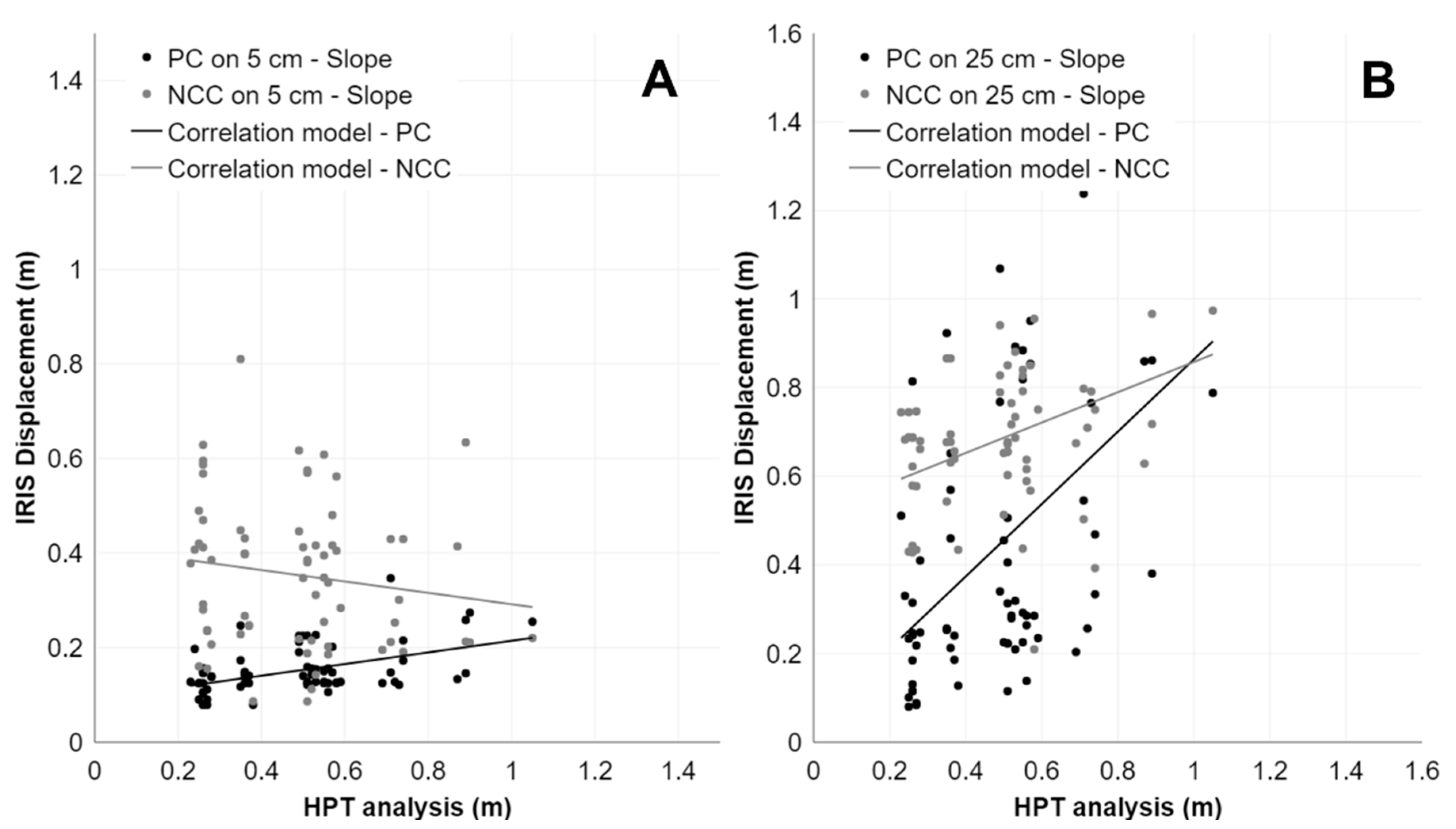
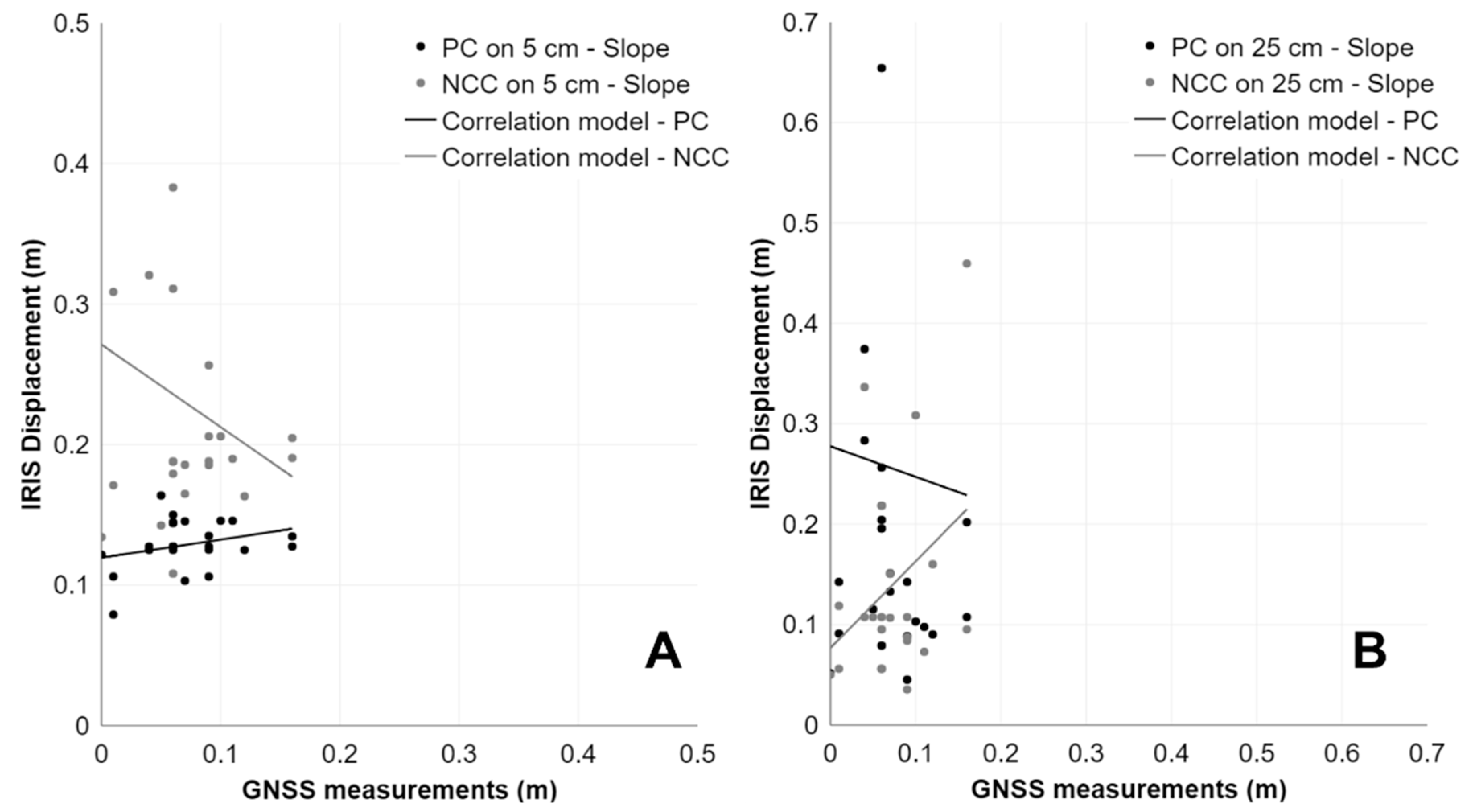
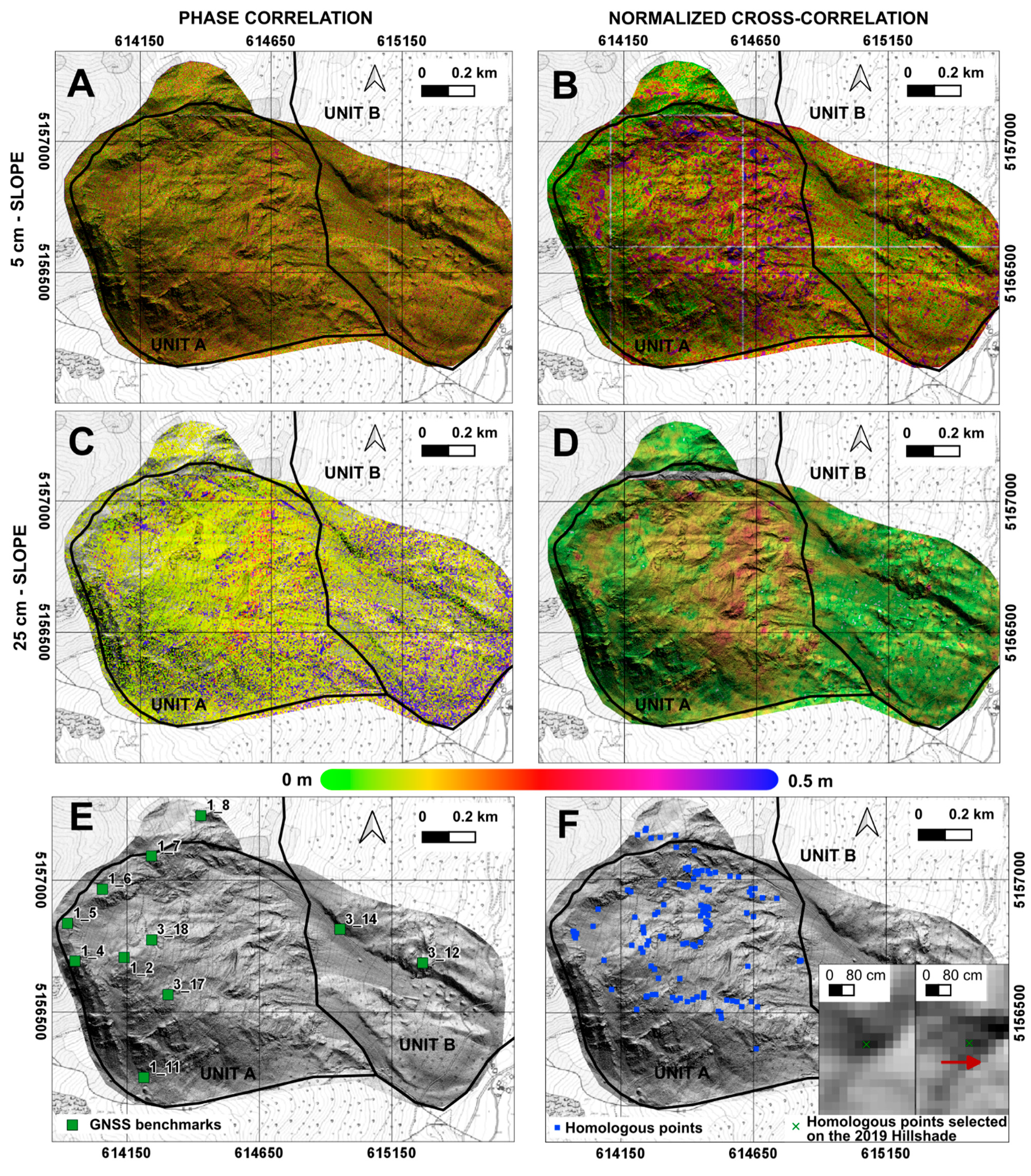


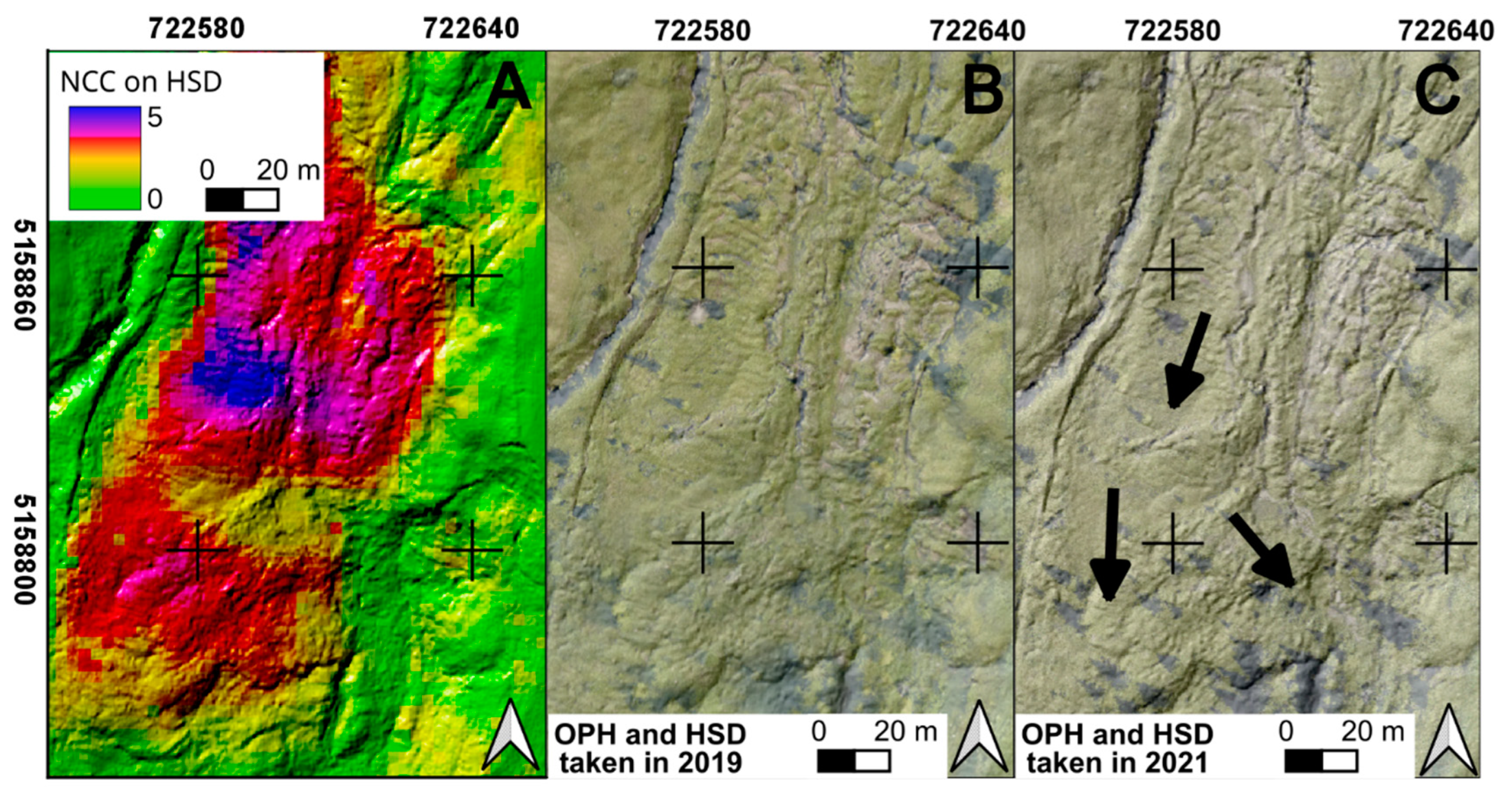
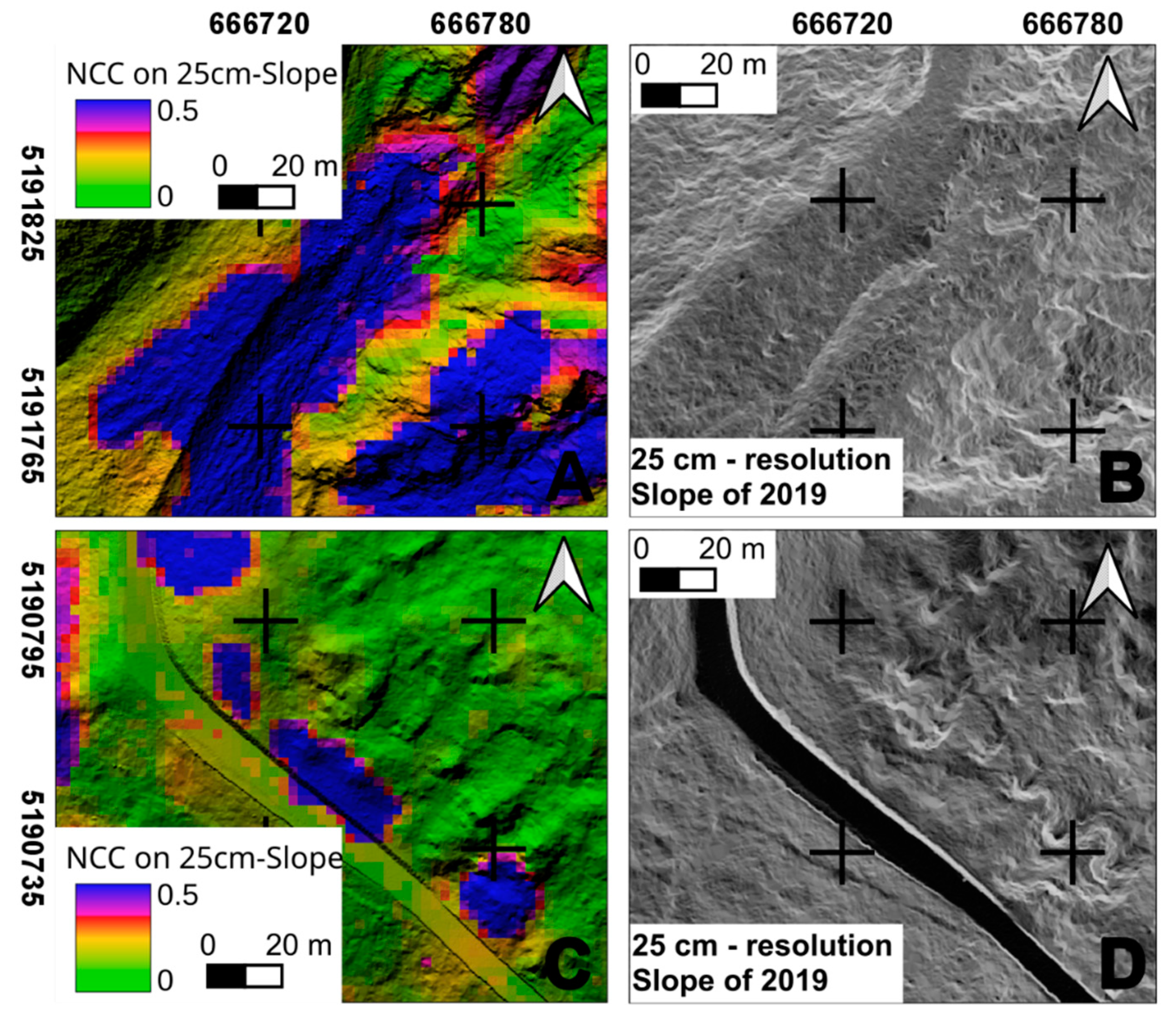
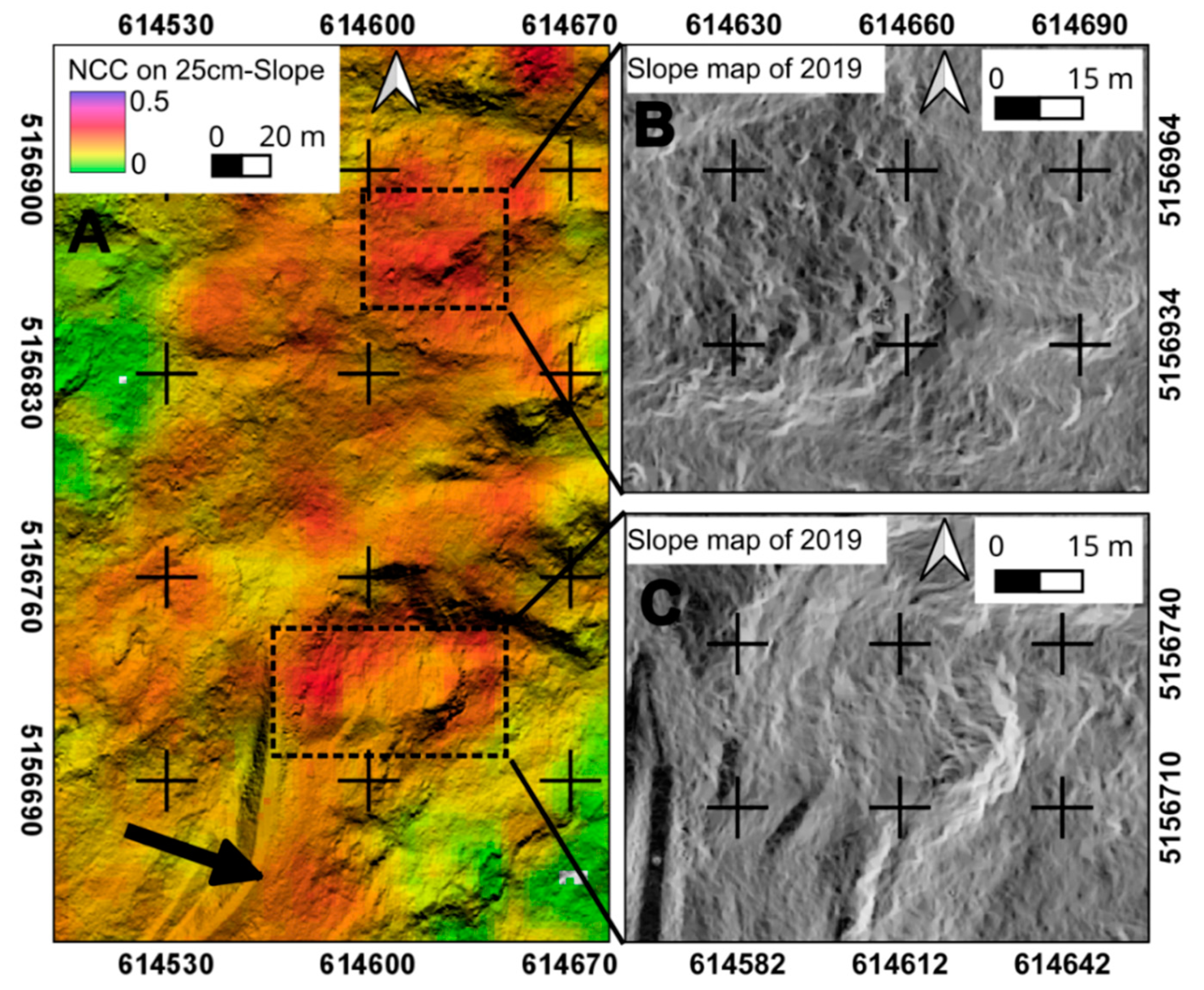
| Site | Date | Extent | Original Data | Format | Resolution |
|---|---|---|---|---|---|
| Corvara | 10, 14 August 2019 30 July 2020 24 August 2021 | 6.5 km2 (34 tiles) | fr-OPH | tiff | 0.05 m/pixel |
| fr-DSM | ascii | 0.25 m/pixel | |||
| fr-DTM | ascii | 0.05 m/pixel | |||
| Ganderberg | 15, 16 August 2019 29 July 2020 23, 24 September 2021 | 11.6 km2 (66 tiles) | fr-OPH | tiff | 0.05 m/pixel |
| fr-DSM | ascii | 0.25 m/pixel | |||
| fr-DTM | ascii | 0.05 m/pixel | |||
| Trafoi | 14 August 2019 28 July 2020 23 September 2021 | 4.3 km2 (29 tiles) | fr-OPH | tiff | 0.05 m/pixel |
| fr-DSM | ascii | 0.25 m/pixel | |||
| fr-DTM | ascii | 0.05 m/pixel |
| Site | Year | Extent | Tiles | Derivative Data | Resolution |
|---|---|---|---|---|---|
| Corvara | 2019 and 2021 (two-years interval) | 6.5 km2 | 11 | OPH | 0.10 m/pixel |
| 3 | HSD | 0.25 m/pixel | |||
| 3 | SLOPE | 0.25 m/pixel | |||
| Ganderberg | 2019 and 2021 (two-years interval) | 6 km2 | 35 | SLOPE-1 | 0.05 m/pixel |
| 4 | SLOPE-2 | 0.25 m/pixel | |||
| Trafoi | 2019 and 2021 (two-years interval) | 1.4 km2 | 9 | SLOPE-1 | 0.05 m/pixel |
| 2 | SLOPE-2 | 0.25 m/pixel |
| Site | DIC Method-Dataset | Search Window (px) | Template Window (px) | Apodization Radius-Search Radius (px) | Subpixel Resolution (px) | Pyramid Levels | Correlation Coefficient Filter | Brighten Factor |
|---|---|---|---|---|---|---|---|---|
| Corvara | PC–OPH | 32 | - | 0.30 | 0.05 | 3 | ≤0.05 | 4 |
| NCC–OPH | 32 | 16 | 1 | 0.05 | 4 | ≤0.05 | 4 | |
| PC–HSD | 32 | - | 0.30 | 0.05 | 3 | ≤0.05 | 4 | |
| NCC–HSD | 64 | 32 | 1 | 0.5 | 4 | ≤0.05 | 4 | |
| PC–SLOPE | 32 | - | 0.30 | 0.05 | 3 | ≤0.05 | 4 | |
| NCC–SLOPE | 64 | 32 | 1 | 0.5 | 4 | ≤0.05 | 4 | |
| Ganderberg | PC–SLOPE-1 | 8 | - | 0.30 | 0.5 | 3 | ≤0.10 | 4 |
| NCC–SLOPE-1 | 128 | 64 | 1 | 0.05 | 4 | ≤0.20 | 7 | |
| PC–SLOPE-2 | 32 | - | 0.30 | 0.05 | 3 | ≤0.05 | 4 | |
| NCC–SLOPE-2 | 128 | 64 | 1 | 0.05 | 4 | ≤0.20 | 7 | |
| Trafoi | PC–SLOPE-1 | 8 | - | 0.30 | 0.5 | 3 | ≤0.10 | 4 |
| NCC–SLOPE-1 | 128 | 64 | 1 | 0.05 | 4 | ≤0.20 | 7 | |
| PC–SLOPE-2 | 32 | - | 0.30 | 0.05 | 3 | ≤0.05 | 4 | |
| NCC–SLOPE-2 | 128 | 64 | 1 | 0.05 | 4 | ≤0.20 | 7 |
| Site | Month/Year | Operator | Technique | Benchmarks (GNSS) |
|---|---|---|---|---|
| Corvara | 10/2019, 11/2020; 09/2021 | Forestry Department | Fast static | 22 |
| Ganderberg | 10–11/2019, 07/2020, 09/2021 | Helica S.r.l. | Fast static and RTK | 23 |
| Trafoi | 10–11/2019, 07/2020, 09/2021 | Helica S.r.l. | Fast static and RTK | 11 |
Disclaimer/Publisher’s Note: The statements, opinions and data contained in all publications are solely those of the individual author(s) and contributor(s) and not of MDPI and/or the editor(s). MDPI and/or the editor(s) disclaim responsibility for any injury to people or property resulting from any ideas, methods, instructions or products referred to in the content. |
© 2023 by the authors. Licensee MDPI, Basel, Switzerland. This article is an open access article distributed under the terms and conditions of the Creative Commons Attribution (CC BY) license (https://creativecommons.org/licenses/by/4.0/).
Share and Cite
Tondo, M.; Mulas, M.; Ciccarese, G.; Marcato, G.; Bossi, G.; Tonidandel, D.; Mair, V.; Corsini, A. Detecting Recent Dynamics in Large-Scale Landslides via the Digital Image Correlation of Airborne Optic and LiDAR Datasets: Test Sites in South Tyrol (Italy). Remote Sens. 2023, 15, 2971. https://doi.org/10.3390/rs15122971
Tondo M, Mulas M, Ciccarese G, Marcato G, Bossi G, Tonidandel D, Mair V, Corsini A. Detecting Recent Dynamics in Large-Scale Landslides via the Digital Image Correlation of Airborne Optic and LiDAR Datasets: Test Sites in South Tyrol (Italy). Remote Sensing. 2023; 15(12):2971. https://doi.org/10.3390/rs15122971
Chicago/Turabian StyleTondo, Melissa, Marco Mulas, Giuseppe Ciccarese, Gianluca Marcato, Giulia Bossi, David Tonidandel, Volkmar Mair, and Alessandro Corsini. 2023. "Detecting Recent Dynamics in Large-Scale Landslides via the Digital Image Correlation of Airborne Optic and LiDAR Datasets: Test Sites in South Tyrol (Italy)" Remote Sensing 15, no. 12: 2971. https://doi.org/10.3390/rs15122971
APA StyleTondo, M., Mulas, M., Ciccarese, G., Marcato, G., Bossi, G., Tonidandel, D., Mair, V., & Corsini, A. (2023). Detecting Recent Dynamics in Large-Scale Landslides via the Digital Image Correlation of Airborne Optic and LiDAR Datasets: Test Sites in South Tyrol (Italy). Remote Sensing, 15(12), 2971. https://doi.org/10.3390/rs15122971






